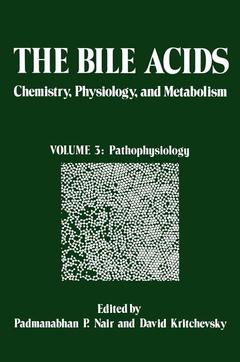Description
The Bile Acids: Chemistry, Physiology, and Metabolism, Softcover reprint of the original 1st ed. 1976
Volume 3: Pathophysiology
Coordinator: Nair P.
Language: English
Subject for The Bile Acids: Chemistry, Physiology, and Metabolism:
Keywords
Colon; Lipid; brain; cancer; chemistry; enzyme; enzymes; influence; metabolism; pathophysiology; physiology; protein; synthesis; tissue
Publication date: 07-2012
230 p. · 15.2x22.9 cm · Paperback
230 p. · 15.2x22.9 cm · Paperback
Description
/li>Contents
/li>
The first two volumes of this series addressed themselves to the chemistry, physiology, and metabolism of the bile acids. The present volume is devoted to the pathophysiology of bile acids. As the role of bile acids in health and disease is being increasingly recognized, we have chosen for discussion a wide range of topics of current importance. The presence of bile acids in brain tissue and their possible role in demyelinating diseases form the subject of a provocative discussion. As an extension of this theme, the presence and quantification of bile acids in extrahepatic tissues is the subject of one chapter. The pathophysiological implications of bile acids at the macromolecular level is highlighted by a chapter on the influence of bile salts on the activity of various enzymes. The general area of hepatobiliary diseases is discussed in two chapters: one describes changes in bile salt metabolism in liver diseases and the other focuses on cholesterol gallstones and their formation and dissolution. Cerebrotendinous xanthomatosis has been shown to entail a defect in bile acid and sterol metabolism, and this metabolic error is the subject of an illuminating exposition. There is presently a concerted research effort being brought to bear on the causes of colon cancer, and one important aspect of this work centers on bile acid metabolism. Aspects of bile acid metabolism and cancer are the subject of two chapters. And finally, the role of dietary fiber in bile acid metabolism is updated.
1 Bile Acids and Brain.- I. Introduction.- II. Brain Cholesterol Biosynthesis.- III. Brain Cholesterol Turnover.- IV. Reactions of Normal Brain Tissue with the Cholesterol Nucleus.- V. Reactions of Brain with the Side Chain of Cholesterol.- VI. Brain, Bile Acids, and the Demyelinating Diseases.- References.- 2 Tissue Distribution of Bile Acids: Methodology and Quantification.- I. Introduction.- II. Extraction Methodology.- III. Tests of Extraction Methods.- A. Liquid—Liquid.- B. Liquid—Solid.- IV. Quantification and Identification Methodology.- V. Tissue Cholanoic Acids: Results of Quantitation.- References.- 3 Bile-Salt—Protein Interactions.- I. Introduction.- II. Nature of Molecular Interactions.- III. Covalent Linkage of Bile Acids to Proteins.- IV. Molecular Interactions and Enzymatic Activity.- A. Sterol Ester Hydrolases.- B. Lipases.- C. Esterases.- D. Arylsulfatases.- E. ?-Galactosidases and Amylase.- F. Nucleotidases and Phosphatases.- G. Peptide Bond Hydrolases.- H. Oxidoreductases.- I. Other Bile-Salt—Protein Interactions.- V. Pathophysiological Implications.- References.- 4 Bile Acids in Hepato-Biliary Diseases.- I. Introduction.- II. Bile Acid Metabolism in Hepatic Diseases.- A. Changes in the Steroid Nucleus.- B. Changes in the Ratio of Glycine and Taurine Conjugates.- C. Sulfation and Glucuronidation.- D. Differences in Bile Acid Metabolism Between Laboratory Animals and Man.- III. Role of Bile Acids in Hepato-Biliary Disorders.- A. Hepatocellular Necrosis.- B. Inhibition of Drug Metabolism.- C. Pruritus.- D. Malabsorption.- E. The Blind Loop Syndrome after Jejuno-Ileal Bypass.- F. Gallstone Formation.- IV. Bile Acid Kinetics, Pattern, and Concentration in Hepatic Disorders.- A. Bile Acids for Diagnosis of Hepatic Disorders.- B. Acute Hepatitis.- C. Chronic Hepatitis and Cirrhosis.- D. Intra- and Extrahepatic Cholestasis.- References.- 5 Pathophysiology and Dissolution of Cholesterol Gallstones.- I. Biliary Lipid Physiology.- A. Cholesterol.- B. Bile Acids.- C. Phospholipids.- D. Bile Acid Regulation of Cholesterol and Phospholipid Metabolism.- E. Biliary Secretion.- II. Pathophysiology of Cholesterol Gallstone Formation.- A. Stages of Gallstone Formation.- B. Mechanism of Cholesterol Saturation.- C. Role of the Gallbladder.- D. Predisposing Factors.- III. Chenodeoxycholic Acid Treatment of Gallstones.- A. Clinical Trials.- B. Mechanism of Action.- C. Dose.- D. Prophylaxis and Retained Stones.- E. Side Effects.- IV. Potential Agents for Treatment of Cholesterol Gallstones.- References.- 6 The Metabolism of Sterols and Bile Acids in Cerebrotendinous Xanthomatosis.- I. Introduction.- II. Clinical Manifestations.- III. Biochemical Findings.- IV. Inheritance.- V. Tissue Concentrations of Cholesterol and Cholestanol in CTX.- A. Brain Tissue.- B. Sterol Composition in Xanthomas.- C. Sterol Composition in Tissues Other Than Brain.- D. Neutral Sterol Composition in Bile.- E. Bile Acid Composition in Bile.- VI. Quantitative Aspects of Cholesterol Turnover.- VII. Measurements of Cholestanol Synthesis by the Sterol Balance and Isotope Kinetic Methods.- VIII. Plasma Lipoprotein Transport and Esterification of Cholestanol.- IX. Cholestanol Biosynthesis.- X. Defective Bile Acid Synthesis in CTX.- References.- 7 Bile Acids and Intestinal Cancer.- I. Introduction.- II. Epidemiological Observations.- III. Fecal Bile Acids and Colon Cancer in the Human.- IV. Investigations of Intestinal Carcinogenesis in Animals.- A. Development of Animal Models.- B. Studies on Bile Acid Involvement.- V. Summary.- References.- 8 Fecal Steroids in the Etiology of Large Bowel Cancer.- I. Introduction.- II. The Epidemiology of Colorectal Cancer.- III. Bile Acids as Carcinogens or Cocarcinogens.- IV. Bacterial Metabolism of Bile Acids in Relation to Colon Cancer.- A. Deconjugation of Bile Salts.- B. Hydroxyl Dehydrogenase.- C. Hydroxycholanoyl Dehydroxylase.- D. Nuclear Dehydrogenation Conjugated to a Keto Group.- E. Aromatization of the A-ring of 3-oxo-4-Cholenic Acid.- F. Aromatization of Steroid Ring B.- G. Other Microbial Modifications of the Bile Acid Molecule.- H. Summary.- V. The Relation of Microbial Metabolism of Bile Acids to Large Bowel Cancer.- VI. The Effect of Diet on the Fecal Steroids, Bacterial Flora, and Gut Physiology.- A. The Effect of Diet on the Gut Bacterial Flora.- B. The Effect of Diet on the Fecal Bile Acid Concentration.- C. The Effect of Diet on the Activity of Bacterial Enzymes in the Gut.- VII. Conclusions.- References.- 9 Dietary Fiber and Bile Acid Metabolism.- Author Index.
© 2024 LAVOISIER S.A.S.



